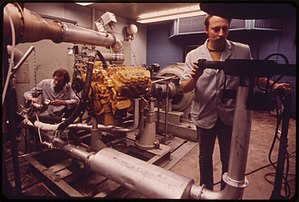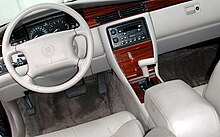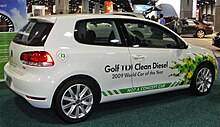
A defeat device is any motor vehicle hardware, software, or design that interferes with or disables emissions controls under real-world driving conditions, even if the vehicle passes formal emissions testing. The term appears in the US Clean Air Act and European Union regulations, to describe anything that prevents an emissions control system from working, and applies as well to power plants or other air pollution sources, as to automobiles.
The United States Environmental Protection Agency (EPA) has taken numerous enforcement actions against car makers and other companies that have used or installed defeat devices, whether deliberately, or through error or negligence. Aftermarket parts or software, such as modified exhausts or chip tuning products and services, are considered defeat devices if they inhibit or bypass a vehicle's emissions controls.
Timeline
1970s

In 1973 the Big Three American automobile manufacturers, Chrysler, Ford Motor Company and General Motors, along with import brand Toyota, were ordered by the EPA to stop using ambient temperature switches which disabled pollution controls at low temperatures. The automakers agreed to cease using the ambient temperature switches in the way the EPA said was in violation of the Clean Air Act, while insisting that the switches were not 'defeat devices' intended to evade rules. The auto companies said the devices improved engine efficiency and actually reduced pollution. The EPA order affected 2 million 1973 model year cars slated for production, but did not require a recall of cars already on the road.
Also in 1973, Volkswagen agreed to a settlement with the EPA, in which they admitted no wrongdoing and paid a $120,000 fine, for failing to disclose the existence of two temperature sensing switches that affected emissions function. In their 1974 model year application to the EPA, VW disclosed the presence of the switches and the EPA rejected them, so they were removed.
1990s

In 1995, General Motors was ordered to recall 470,000 model year 1991 through 1995 Cadillacs and pay an $11 million fine for programming the car's electronic control unit (ECU) to enrich the fuel mixture any time the car's air conditioning or cabin heat was operating, since the EPA tests are conducted with those systems turned off. The richer fuel mixture was needed to address an engine stalling problem, resulting in emissions of up to 10 grams per mile of carbon monoxide (CO), nearly three times the limit of 3.4 g/mi. While the EPA and Justice Department contended that GM intentionally violated emissions standards, GM said that was "a matter of interpretation." Besides the fine, the second largest Clean Air Act penalty to date in 1995, GM had to spend up to $34 million for anti-pollution programs and recall 470,000 Cadillac 4.9 liter Eldorados, Fleetwoods, DeVilles, and Sevilles. The largest civil penalty under the Clean Air Act was $11.1 million paid by Louisiana-Pacific lumber and paper company.
In 1996, Honda reached an agreement with the EPA to extend the warranties and offer free services for 1.6 million 1995 Civics and 1996–1997 model year Acuras, Accords, Civics, Preludes, and Odysseys, because Honda had disabled an engine misfire monitoring device that would have otherwise directed drivers to seek repairs. Honda was required to spend a total of $254 million on the warranties, service, pollution reduction projects, and $12.6 million in civil penalties.
Also in 1996, Ford reached a consent decree to spend $7.9 million to address a defeat device on 60,000 1997 model year Econoline vans which used a "sophisticated electronic control strategy designed to enhance fuel economy", disabling NOx emissions controls while the vans were driven at highway speeds, a circumstance not occurring during lab testing to verify emissions control compliance.
In 1998, the EPA announced fines totaling $83.4 million against seven diesel engine manufacturers, the largest fine to date, which evaded testing by shutting down emissions controls during highway driving while appearing to comply with lab testing. The seven, Caterpillar, Cummins, Detroit Diesel, Mack Trucks, Navistar International, Renault Trucks, and Volvo Trucks, also agreed to spend more than $1 billion to correct the problem. The trucks used engine ECU software to engage pollution controls during the 20-minute lab tests to verify compliance with the Clean Air Act, but then disable the emissions controls during normal highway cruising, emitting up to three times the maximum allowed NOx pollution.
2000s
In 2000 the German motorcycle magazine Motorrad reported about a defeat device delivered with the BMW F 650 GS. BMW responded by issuing an improved injection as of 2001 and calling back the models from the previous year.
2010s

In late 2015, the EPA discovered that software used in millions of Volkswagen Group turbocharged direct injection (TDI) diesel engines included features intended to produce misleading results during laboratory emissions testing.
On 10 October 2015, Consumer Reports tested a 2015 Jetta TDI and a 2011 Jetta Sportwagen TDI in what they presumed was the special emissions testing, or cheat mode. The 0 to 60 mph (0 to 97 km/h) acceleration time of the 2011 Jetta increased from 9.9 to 10.5 seconds, and the 2015 car's time went from 9.1 to 9.2 seconds. The fuel economy of the 2011 car decreased from 50 to 46 mpg‑US (4.7 to 5.1 L/100 km; 60 to 55 mpg‑imp) and the 2015 car's fuel economy decreased from 53 to 50 mpg‑US (4.4 to 4.7 L/100 km; 64 to 60 mpg‑imp). Consumer Reports's Director of Auto Testing said that while the added fuel costs, "may not be dramatic, these cars may no longer stand out among many very efficient competitors." The method the magazine used to engage cheat mode while driving required making assumptions about the ECU's operations. Because disabling electronic stability control is a necessary step for running a car on a dynamometer, the magazine assumed that this would put the car in cheat mode. In order to keep the electronic stability control from reactivating while driving, they disconnected the cars' rear wheel speed sensors, simulating the inputs the ECU receives while the car is on a stationary test rig, even though it was being driven on the road. Besides front and rear wheel speeds, the EPA had said that steering wheel movement, barometric pressure and duration of engine operation were factors in triggering cheat mode.
Fiat Chrysler produced over 100,000 model year 2014 through 2016 Ram 1500 and Jeep Grand Cherokee vehicles for sale in the United States with EcoDiesel engines in which the US EPA and the California Air Resources Board alleged had a defeat device.
Notes
- ^ United States Code of Federal Regulations:
- ^ European emission standards:
- FAQ – Air pollutant emissions standards Archived 2015-10-13 at the Wayback Machine European Commission, 25 September 2015. Quote: Article 5 (2) of Euro 6 Regulation 715/2007/EC prohibits the use of defeat devices. Article 3(10) defines defeat device as any element of design which senses temperature, vehicle speed, engine speed (RPM), transmission gear, manifold vacuum or any other parameter for the purpose of activating, modulating, delaying or deactivating the operation of any part of the emission control system, that reduces the effectiveness of the emission control system under conditions which may reasonably be expected to be encountered in normal vehicle operation and use.
- REGULATION (EC) No 715/2007 OF THE EUROPEAN PARLIAMENT AND OF THE COUNCIL Archived 2017-01-19 at the Wayback Machine of 20 June 2007. Articles 3, 5, 13 on pages 5-9
- ^ United States Environmental Protection Agency (8 July 2015), Air Enforcement, archived from the original on 19 September 2015, retrieved 27 September 2015
- "Auto makers and EPA split victories on '73 vehicles", Chronicle-Telegram, – via Newspaperarchive (subscription required) , 22 January 1973
- ^ United Press International (23 January 1973), "Defeat Devices Must Go", The News Herald (Panama City), – via Newspaperarchive (subscription required)
- ^ "VW emissions 'defeat device' isn't the first", AutoWeek, 24 September 2015, archived from the original on 26 September 2015, retrieved 26 September 2015
- ^ Myers, Laura (1 December 1995), "Cadillacs Recalled To Remove Illegal Device", The Buffalo News, Buffalo, New York, Associated Press, archived from the original on 15 October 2015 – via HighBeam
- ^ Alexander, David E. (August 1998), Clean Air Act Prohibits "Defeat Devices" in Vehicles, Engines; Honda to Spend $267 Mil, Ford $7.8 Mil. to Settle Charges (Adobe PDF), United States Environmental Protection Agency, archived (PDF) from the original on 14 April 2020, retrieved 28 September 2015
- United States Environmental Protection Agency (22 October 1998), Mack Trucks Diesel Engine Settlement, archived from the original on 2 October 2015, retrieved 27 September 2015
- ^ Plungis, Jeff; Bloomberg News (27 September 2015), "Carmakers cheating on emissions almost as old as pollution tests", Daily Herald, archived from the original on 28 September 2015, retrieved 28 September 2015
- Pfeiffer, Michael (4 December 2015). ""Motorrad"-Chefredakteur verteidigt Bericht zu BMW-Software: Defeat Gate auch bei Funduro-Maschine?" [chief editor defends report about BMW software: Defeat-gate for funduro-bike, too?] (in German). Archived from the original on 12 June 2018. Retrieved 29 December 2015.
- Schwarz, Waldemar. "Technik: Abgasreinigung – MOTORRAD 14/2000". Archived from the original on 29 December 2015. Retrieved 29 December 2015.
- Burt, Matt (23 September 2015). "VW emissions scandal: how Volkswagen's 'defeat device' works". Retrieved 28 September 2015.
- ^ Fisher, Jake (9 October 2015), "Consumer Reports Tests VW Diesel Fuel Economy, Performance in 'Cheat' Mode; Tests reveal different results when the 'cheat' settings are used in the real world", Consumer Reports, archived from the original on 14 April 2019, retrieved 9 March 2021
- Brooks, Phillip A. (18 September 2015). "VW Notice of Violation, Clean Air Act (September 18, 2015)" (PDF). US Environmental Protection Agency. Archived (PDF) from the original on 19 September 2015. Retrieved 20 September 2015.
- "In Civil Settlements with the United States and California, Fiat Chrysler will Resolve Allegations of Cheating on Federal and State Vehicle Emission Tests". U.S. Department of Justice. 10 January 2019. Archived from the original on 14 April 2019. Retrieved 14 March 2019.
References
- United States Environmental Protection Agency (22 October 1998), Mack Trucks Diesel Engine Settlement, archived from the original on 2 October 2015, retrieved 27 September 2015